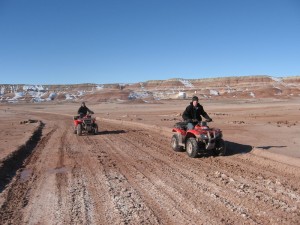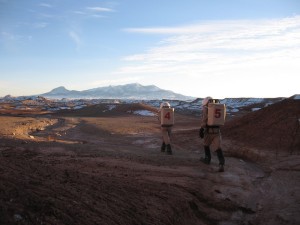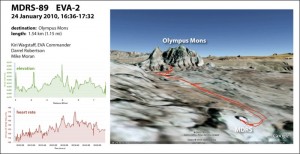It’s been another snowy day here, although the temperature got up to 50 F and the snow is rapidly melting. We foresee mud in our futures!
This morning, our Internet service went out again. Brian and I suited up to go out and again knock snow off the satellite receiver. Rather than going through all the trouble of an EVA (getting our suits on, depressurizing the airlock, going out, coming back, re-pressurizing the airlock, and getting the suits off) just for that, we added some additional useful tasks to make the most of our time. We also planned to measure the length of coax cable that Mike needed for connecting the new, taller radio telescope; measure the depth of snow accumulation; clean the mud off the ATV tires and test their operation in the snow; and experiment with the “VOX” (voice-operated) radio setting (which does not require push-to-talk). While we were getting ready, the snow must have melted or fallen off on its own, because Internet access was restored; but we decided to proceed with our plans and accomplish our other goals regardless. Outside, the whiteness was nearly blinding, even with sunglasses on. We discovered that we’d gotten 3 inches of snow from the storm yesterday! We cleaned off the ATV tires, inflated a few low tires, and then took the ATVs out for a spin in the Hab “parking lot” area. The snow was indeed a little slippery, but we found they felt okay if we went slow. More challenging was the fact that everything was unvaryingly white, making it very hard to tell where the ground sloped up or down or where rocks were; the diffuse light meant no shadows and no relief! We think we may be able to drive on nearby Lowell “Highway”, but probably not any of the side trails, where getting stuck would be quite likely and quite inconvenient. We came back in and then everyone assembled for a pre-lunch Jazzercise session. This was a total blast! We folded up our dining table and laid five mats (normally used for padding under our sleeping bags) on the floor. Five mats because Luis has been feeling under the weather and instead alternated between operating the video camera and cheering us on. I put in the first Jazzercise DVD and we ran through several routines, stretching and jumping and kicking and breathless with laughter at how ridiculous we must look. (We’re wondering whether anyone was watching the webcams at that time!) We then sat down for some tortilla soup. Brian made tortilla chips by slicing tortillas and microwaving them — I didn’t know you could do that! They were nice and crunchy with the soup. Carla made a divine pear spice cake that was so good we can’t wait to have it after dinner as well. After lunch, Mike and Carla went outside for another EVA to raise the south poles of the radio telescope (to 20 feet tall). They also installed the coax cables and checked the tension on the support lines. The frozen ground made adjusting some of the support lines impossible, so this will have to be done during a future EVA. As a reward for their hard work, they then constructed a custom Martian snowman with two heads. We could see them from the Hab porthole windows! Meanwhile, The Viking-2 ATV has been inoperable for some time, so Darrel thought he would see about fixing it. Darrel removed Viking-2’s carburetor and he and Luis disassembled it for cleaning. They then boiled it on the stove in soapy water, scrubbed the pieces with a toothbrush, and boiled it in clean water. It is now drying and will be reassembled and tested later. Soon we may have four ATVs instead of three!Carburetors aren’t the only things cooking in our kitchen tonight. Darrel previously cleaned out the breadmaker tray (which was, let us say, simply disgusting), and we currently have whole wheat bread with garlic and oregano baking. Brian is making fried tofu and couscous that jointly smell absolutely divine. Darrel, Mike, and Luis are outside doing engineering rounds. Apparently the clouds have rolled away and the moon and stars are putting on quite a show, so they also took a camera and tripod to capture some night shots.
With luck, we’ll all get our reports in early enough to watch another movie tonight. Anything would beat last night’s movie (“Stranded”). Really, *anything*!


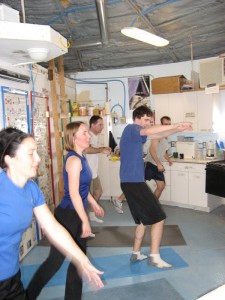
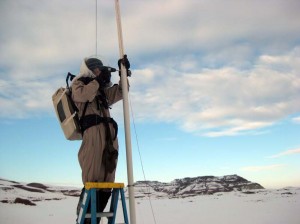

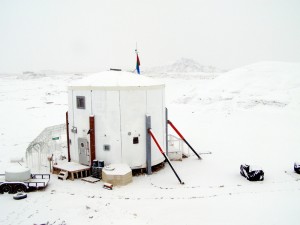
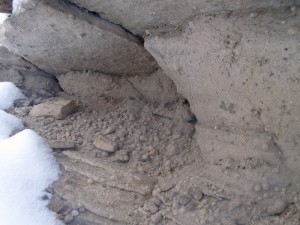

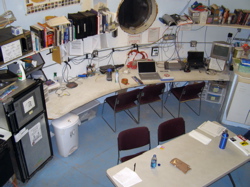 So, we’ve gotten used to these surroundings in the few days that we’ve been here, especially the upper deck of the Hab. This is where most of the work gets done: filing reports at the end of each day, planning EVAs, cooking, eating, relaxing, and bonding as a team. The space is very multi-purpose, with the main central table serving as both a kitchen table and a workstation (or game table), the kitchen sitting right next to the main workbench, and it allows access to every other part of the Hab.
So, we’ve gotten used to these surroundings in the few days that we’ve been here, especially the upper deck of the Hab. This is where most of the work gets done: filing reports at the end of each day, planning EVAs, cooking, eating, relaxing, and bonding as a team. The space is very multi-purpose, with the main central table serving as both a kitchen table and a workstation (or game table), the kitchen sitting right next to the main workbench, and it allows access to every other part of the Hab.
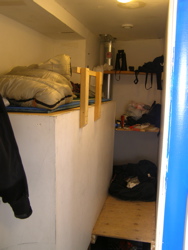 Our day, however, begins in the state rooms, each of which is composed of nothing more than a bunk and a small desk (and a few have installed shelving). For most of us, these state rooms are just for sleeping and storing anything we can’t leave out in the main room, although Brian and Carla do complete quite a bit of work in their larger rooms as benefit to being our Commander and XO, respectively. While my state room, pictured to the right, is quite messy, it’s more to allow access to anything I may need immediately, hence the spread of supplies on my desk.
Our day, however, begins in the state rooms, each of which is composed of nothing more than a bunk and a small desk (and a few have installed shelving). For most of us, these state rooms are just for sleeping and storing anything we can’t leave out in the main room, although Brian and Carla do complete quite a bit of work in their larger rooms as benefit to being our Commander and XO, respectively. While my state room, pictured to the right, is quite messy, it’s more to allow access to anything I may need immediately, hence the spread of supplies on my desk. Since we are in sim, the only time we can leave the Hab (aside from engineering rounds, which I’ll get too later) is while on EVA, or Extra-Vehicular Activity; those trips start in the EVA Prep Room, pictured to the right. Here is where we store everything that is needed for an EVA, at least everything that can be carried that isn’t specifically engineering related. During the suit-up procedure, the Marsonauts first put on their flight suits (hanging in the background). When we first arrived at MDRS, we tried on the suits until we found one that would fit, then Velcro-ed our mission patch and name tags onto our selected flight suits. They then don their boots and waders, along with their radios and headsets. At this point, their is usually also a com check between the Marsonauts and HabCom (the person who stays behind to communicate with those on the surface) before the suit-up procedure progresses.
Since we are in sim, the only time we can leave the Hab (aside from engineering rounds, which I’ll get too later) is while on EVA, or Extra-Vehicular Activity; those trips start in the EVA Prep Room, pictured to the right. Here is where we store everything that is needed for an EVA, at least everything that can be carried that isn’t specifically engineering related. During the suit-up procedure, the Marsonauts first put on their flight suits (hanging in the background). When we first arrived at MDRS, we tried on the suits until we found one that would fit, then Velcro-ed our mission patch and name tags onto our selected flight suits. They then don their boots and waders, along with their radios and headsets. At this point, their is usually also a com check between the Marsonauts and HabCom (the person who stays behind to communicate with those on the surface) before the suit-up procedure progresses. 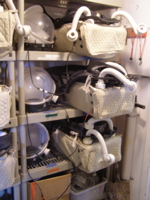 Once everything checks out, they then strap into their PLSS (Portable Life Support System), usually with the help of someone in the ready room. This backpack allows the EVA personnel to survive outside of the Hab as it filters and transfers breathable air to the helmet, which is put on next. A final check is made before the Marsonauts enter the airlock, where they must wait for five minutes for depressurization, before leaving the Hab and stepping out onto the surface. Once they return, this process is repeated in reverse, usually followed by a hot meal for the returning explorers.
Once everything checks out, they then strap into their PLSS (Portable Life Support System), usually with the help of someone in the ready room. This backpack allows the EVA personnel to survive outside of the Hab as it filters and transfers breathable air to the helmet, which is put on next. A final check is made before the Marsonauts enter the airlock, where they must wait for five minutes for depressurization, before leaving the Hab and stepping out onto the surface. Once they return, this process is repeated in reverse, usually followed by a hot meal for the returning explorers. During the day, a lot of the work is completed in the lower deck, which includes the EVA Prep Room, main airlock, Biology and Geology labs, engineering bay and airlock, as well as the bathroom and shower. Since our completed EVAs (four in total) haven’t been centered on either Biology and Geology, the main lab area (pictured) has mostly just been inventoried and cleaned by LuÃs, our Biologist. There is an EVA out currently that focuses on geology and geophysics, plus there is a planned EVA later today centered on biology, so this area will mostly likely being in use more for the rest of the mission. Darrel, our Engineer, is also using the area as an interior engineering bay and repair station for basically the entire Hab.
During the day, a lot of the work is completed in the lower deck, which includes the EVA Prep Room, main airlock, Biology and Geology labs, engineering bay and airlock, as well as the bathroom and shower. Since our completed EVAs (four in total) haven’t been centered on either Biology and Geology, the main lab area (pictured) has mostly just been inventoried and cleaned by LuÃs, our Biologist. There is an EVA out currently that focuses on geology and geophysics, plus there is a planned EVA later today centered on biology, so this area will mostly likely being in use more for the rest of the mission. Darrel, our Engineer, is also using the area as an interior engineering bay and repair station for basically the entire Hab. Speaking of engineering, the Hab also requires a power supply separate from the Hab and its vicinity. In a future Martian habitat, this power station will be much more than a diesel engine, so it needs to be separated from the Hab for the safety of the astronauts. During engineering rounds, Darrel and usually one other member of the crew (recently it has been either Kiri or Carla) check the power supply, batteries, ATVs, general Hab upkeep, Green Hab (which is both a greenhouse and a water recycling facility), and the various systems that are required in order to keep everything running smoothly. During a typical day, rounds are made in the morning (following the meeting) and at night before our mission support window opens at 2000 Local Time. This gives the engineer enough time to make the measurements and other checks, fix anything that needs fixing, and file a report so that (for any major problems), Mission Support can help troubleshoot things.
Speaking of engineering, the Hab also requires a power supply separate from the Hab and its vicinity. In a future Martian habitat, this power station will be much more than a diesel engine, so it needs to be separated from the Hab for the safety of the astronauts. During engineering rounds, Darrel and usually one other member of the crew (recently it has been either Kiri or Carla) check the power supply, batteries, ATVs, general Hab upkeep, Green Hab (which is both a greenhouse and a water recycling facility), and the various systems that are required in order to keep everything running smoothly. During a typical day, rounds are made in the morning (following the meeting) and at night before our mission support window opens at 2000 Local Time. This gives the engineer enough time to make the measurements and other checks, fix anything that needs fixing, and file a report so that (for any major problems), Mission Support can help troubleshoot things.